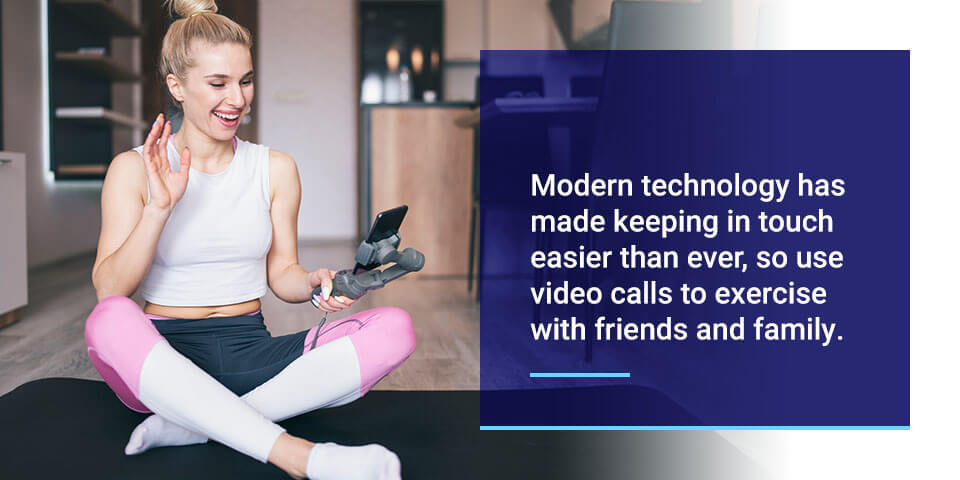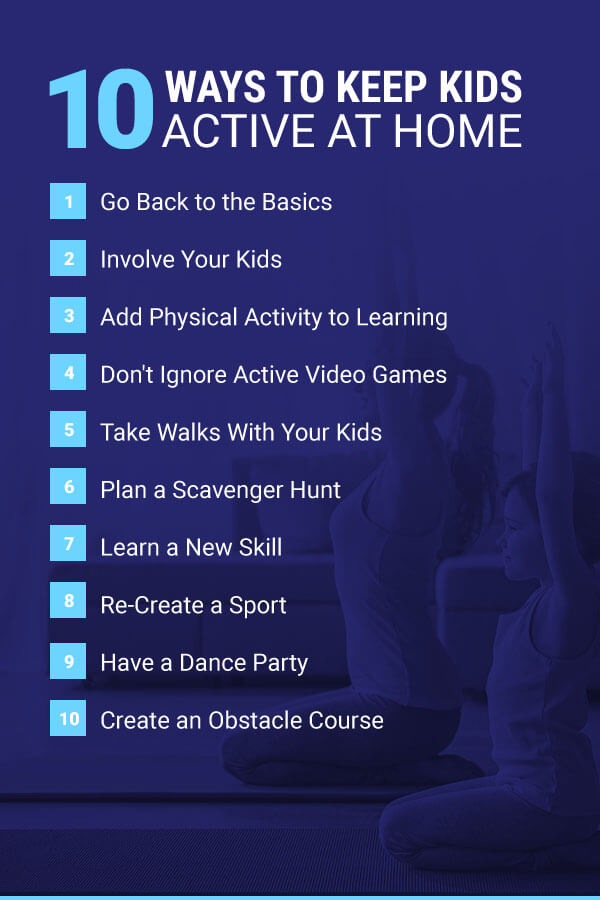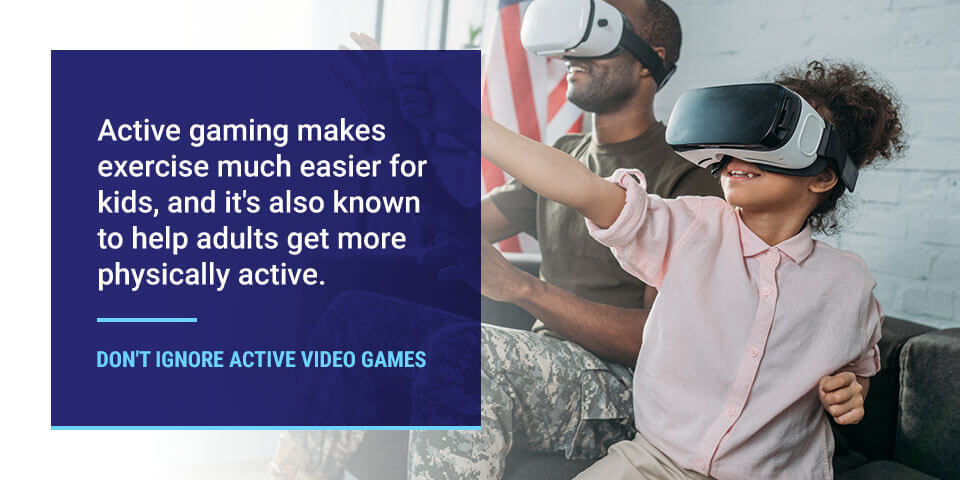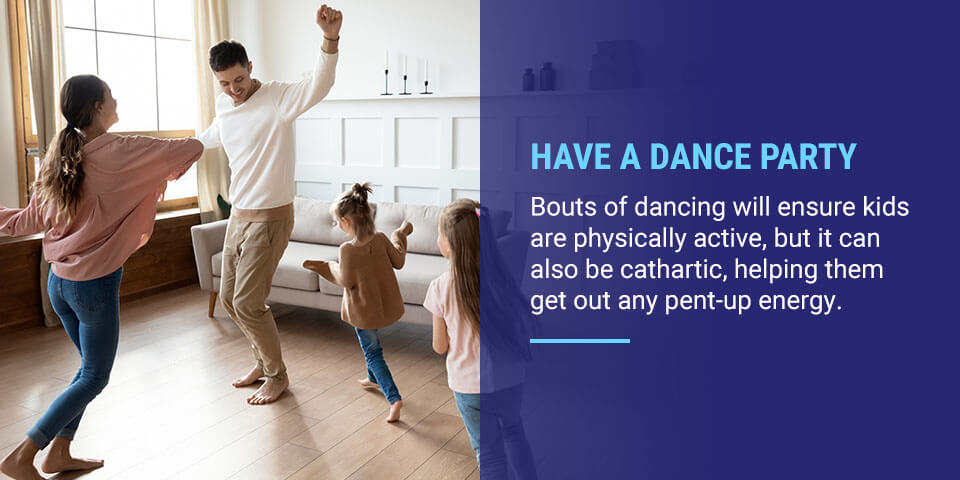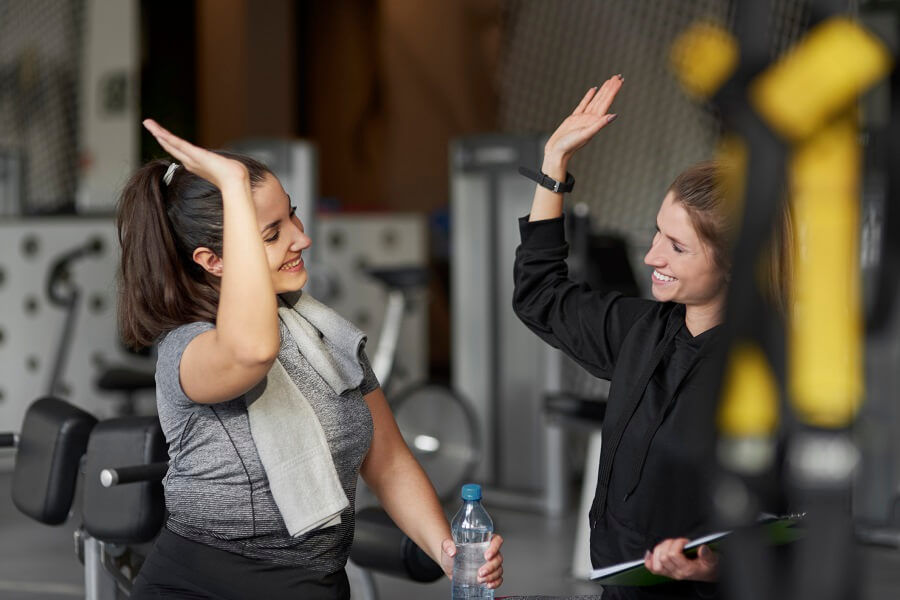30 Physical Activities for All Ages
30 Physical Activities for All Ages
Posted on: August 8, 2023 in Exercises
30 Physical Activities for All Ages
It’s no secret that physical activity is crucial to a healthy lifestyle. Movement of any sort promotes good heart health, strong bones and improved balance. Sitting around all day can even reduce how long you live. Studies have shown that even small bits of physical activity throughout the day will lengthen and improve your life. Studies have also shown that exercise can blunt the effects of viruses, such as COVID.
However, it can be difficult to find at-home exercise activities to perform daily. Whether it’s for health reasons or simply a lack of access to proper equipment, finding ways to increase physical activity at home can be a challenge. The good news is that you’re probably more active than you think. Using the stairs in your home or building, taking pets for walks and even scrubbing stubborn grease off dishes all count as physical activities.
10 Easy Physical Activities for Adults
If you work from home or have children who get restless when they’re cooped up inside, you’re probably wondering how to best keep everyone entertained and active at the same time. Luckily, there are many easy physical activities you and your family can do in or around your home. Below are 10 physical activity ideas for adults:
1. Create an At-Home Workout Routine
Some people thrive on routines, even outside of obligations. Adding physical activity to your everyday routine can normalize it and increase the chance that you’ll do it every day. Find the best time for you to squeeze in a workout. If you’re not a morning person, don’t force yourself to wake up at the crack of dawn to go for a jog. Instead, fit in physical activity during the afternoon.
Then, take it a step further and plan out what exercises you’ll do each day. You may decide to do yoga one day, ride a bike — stationary or regular — the next day and have a dance party with your kids the third. Or, you can opt to divide up the day by focusing on different areas of the body. There are infinite ways to create a workout routine that fits with your goals and ability, so do a little experimenting to see what routine works for you.
2. Set Goals for Yourself
Sometimes it’s easier to accomplish a task when you have a goal to work toward. Goals can be as simple as aiming for 150 minutes of physical activity a week, as recommended by the Centers for Disease Control. Or, you can aim for something more challenging, such as gaining muscle or training for a marathon.
You can even communicate with your gym or personal trainer and get advice on which goals to set and how to work toward them in a safe and effective way.
3. Improvise Exercise Equipment
If you feel you’re limited by a lack of exercise equipment, find ways to improvise. You can use full water bottles or cans of food to lift weights or use the stairs in place of a stair machine. You can also use furniture or the walls of your home for resistance exercises.
You can even add to your daily physical activity by simply changing the way you use everyday equipment. For example, run or jog up the stairs instead of walking to get your heart rate up. Try including physical activity in situations that are normally sedentary, like doing gentle stretches while watching TV or using commercial breaks to do some squats or pushups. If you’re streaming all your shows, increase activity by using the time between episodes to do burpees.
Walking is a great exercise that only requires your legs, so go for several short walks around your home — that counts as physical activity, too.
4. Take Advantage of Online Classes
Many gyms offer online workouts that you can do in the comfort of your own home, so take advantage of them. These virtual group classes range from aerobics to yoga and Pilates, allowing you to keep up your exercise regiment in a convenient way.
Virtual classes and even fitness DVDs provide great examples of physical activities you can do at home since they allow you to get everything from cardio to stretching in one place. You can also choose which classes to join based on your fitness level and long-term goals.
5. Get Some Fresh Air
If walking around your living room gets dull, step outside and take a stroll around your backyard if you have one. Or take your dog for a walk and spend some time playing, so everyone gets some much-needed activity. A hike is a great way to get outdoors while still abiding by social-distancing rules, so take advantage of a hiking trail nearby.
Relive your childhood by busting out a hula-hoop or jump rope. These games aren’t just for kids and can be a great source of cardio.
6. Do Cardio at Home
Those who have space can bring the hula-hoop indoors as well, but there are many ways to do cardio exercises at home. Simple activities like jumping jacks and burpees are a great way to get your heart rate going. If you have a stationary bike or a treadmill at home, use it to work on your cardio as well.
Getting creative can come in handy when you want to increase activity while at home, and dancing is an underrated way to do it. Dancing provides the same cardio benefits as running or aerobics, and more people find it enjoyable. Having impromptu dance parties at home is an excellent way to get the heart racing, boost cognitive functions and improve your body’s strength.
7. Find Reasons to Get Up
Some physical activity is better than no physical activity at all, and if you work from home or live a sedentary life, it’s important to get up and move around every hour. Set a timer or an alarm to remind yourself to get up every hour. Use the time to get in some stretches or even a few jumping jacks before sitting back down again.
It can be difficult to find time to move and be active when working from home, but a little innovation can go a long way. Consider taking a walk around the house while on a business phone call or pile some boxes onto your desk to create a makeshift standing desk.
8. Remember That Chores Count Too
Household chores are some of the most underrated examples of physical activities you can do at home, and you’d be surprised at how much energy they require. In fact, studies have found that household chores are just as effective as working out at the gym or running every day. They help keep your heart healthy while keeping your house clean — a win-win solution.
So, don’t forget to include the vacuuming and gardening when you’re wondering about your physical activity levels since both these activities are great for muscle development. Gardening and other yard work are some of the best ways to be physically active while at home. The effort and repetitive motions of chores like mulching, raking and weeding provide similar results as lifting weights.
9. Keep Yourself Motivated
Exercising can be dull, which is why a quarter of all Americans don’t do enough of it. Motivation has a lot to do with it, and it can be even harder to find when you’re stuck at home.
A simple change in routine can do wonders, so instead of doing the same exercises or activities every day, switch them up. Alternating exercise routines by day is a common way to beat the lack of motivation, but being at home affords a lot more perks. For example, use a treadmill or stationary bike while watching your favorite TV show. You may even be surprised at how quickly your workout gets done.
Modern technology has made keeping in touch easier than ever, so use video calls to exercise with friends and family. You can catch up and even give each other the motivation to be physically active as well. Or, if you’re a fan of photography, take more walks and hikes with your camera to snap some shots while getting your steps up.
10. Involve the Whole Family
Keeping children busy doesn’t have to involve screen time. Instead, include the family in your activities. Go for hikes or bike rides together, play games in the backyard or divide up home and garden chores, so everyone gets some activity in.
10 Ways to Keep Kids Active at Home
When your kids are out of school, you may find that they are getting restless or spending more time being sedentary. In addition to keeping yourself physically active, it’s important to make sure kids are getting daily physical activity as well. Lack of school and extracurricular activities means a lack of routine, including opportunities for physical activity.
So, here’s a list of physical activities for kids to help entertain them while keeping them healthy:
1. Go Back to the Basics
The childhood games you played as a kid can be recycled to be new again for your children. Hide and Seek, Freeze Tag and Duck, Duck, Goose are just some of the simple games that will entertain kids while making sure they’re being physically active. Hula-hoops and skipping ropes are other timeless toys that promote activity. Have contests to see who can keep the hula-hoop up the longest, or create rhymes and songs to jump rope to for an added bit of creativity.
The best part of these games is that they can be played outdoors or indoors, allowing for year-round activity.
2. Involve Your Kids
If gardening is a way for you to relax, try involving your kids, as well. Give them simpler chores that still require them to be active and enjoy the fruits of your labors together. If involving them in less interesting chores, like mopping or doing the dishes, isn’t enough, involve them in “fun” chores, like mowing the lawn or raking leaves.
Bigger activities, like cleaning out the garage or attic, are ideal for getting kids to help. Additional help will make the work get done faster and provide opportunities to increase activity.
3. Add Physical Activity to Learning
Make homework and studying fun by creating “missions” for your kids to complete. Design the missions to align with their schoolwork to implement a learn-by-doing method, which can help kids learn.
If your child needs help with math, send them on a mission to count all the windows in the house, then ask them to figure out the average number of windows in every room. Similar missions can take place in the kitchen by having kids measure out ingredients to help you bake.
4. Don’t Ignore Active Video Games
Video games often get a bad reputation for inspiring laziness and promoting violence, but studies have shown that active gaming is a useful tool for promoting health and physical activity. Fitness and exercise video games are designed to be played with the whole body, requiring players to jump and move around to progress.
Active gaming makes exercise much easier for kids, and it’s also known to help adults get more physically active. Play these games with your kids to get a workout and some quality time.
5. Take Walks With Your Kids
A walk is a great way to bond with your kids while doing something active. Walk around your neighborhood or a nature trail, and use the time to engage your kids in conversation about what they see. Discover plants and wildlife and help nurture their interests and curiosity while enjoying the benefits of physical activity.
6. Plan a Scavenger Hunt
If you want some time to do your own workout in peace but need to keep the kids safely occupied, set up a scavenger hunt for them to complete. Hide the objects to scavenge around your home in spots that require crawling, jumping or even climbing. They won’t even realize they’re getting exercise because they’ll be too busy having fun.
7. Learn a New Skill
The internet is full of videos that can help your kids learn new skills. Engage them in a new hobby by finding a virtual class they can take, such as martial arts or gymnastics.
You can even join in, especially if your kids are younger, and get your own workout in, while making sure your kids are safe.
8. Re-Create a Sport
Your kids may not be able to play soccer or basketball in the house, and you may not have a private outdoor space for such sports, but with a little creativity, you can recreate these sports to adapt to your situation. Blow up a balloon and use it to play a game of volleyball, or line up some bottles of water and use a tennis ball to bowl a strike.
Another classic childhood game to bring back is Hot Potato. Use a plush toy as the hot potato and throw it to each other. Similarly, a simple game of catch with each other or even against a brick wall puts both leg and arm muscles to use.
9. Have a Dance Party
There are many benefits to dance, and it can be a fun and stress-relieving activity for kids, too. Set time aside each day to allow kids to dance around the house. Bouts of dancing will ensure kids are physically active, but it can also be cathartic, helping them get out any pent-up energy.
If your kids are really into dancing after your impromptu dance parties, look into virtual dance courses designed for kids.
10. Create an Obstacle Course
Pillows, blankets and some masking tape are all you really need to create an engaging and challenging obstacle course in your home. Besides being a way to keep kids active, obstacle courses can also help develop problem-solving and teamwork skills. Make the obstacle course one that involves a combination of running, jumping and crawling to get a full-body workout for kids.
For an additional challenge, use a stopwatch or timer to see how quickly they can complete the obstacle course and aim to lessen the length of time.
10 Tips for Seniors to Stay Active at Home
If you’re an older adult, staying physically active can come with certain challenges. Mainly, you have to be more mindful of the limitations of your body to avoid injury. However, there’s no reason why seniors can’t be physically active to an extent. Here is a list of physical activities best suited for seniors to help get you started:
1. Challenge Yourself
Everyone is different, and what may be an easy workout for one person may be too difficult for another. Knowing your body and its limitations is crucial, but so is pushing yourself a little with every activity. If you do too much too soon, you risk injury, but if you don’t push yourself at all, you risk losing the benefits of physical activity.
2. Don’t Overdo It
Overdoing physical activity puts you at a greater risk for injury, which can leave you unable to do any workouts at all while you heal. The ideal time to conclude your workout is before you start feeling sore. Soreness, like any other injury, will take time to heal, potentially preventing you from any activity in the meantime.
3. Practice the Four Types of Exercise
A good workout should touch on the four types of exercise that help make an overall healthy body:
- Flexibility: Exercises that help you move more freely.
- Strength: Exercises that help develop muscular strength.
- Balance: A necessary part of the exercise, especially as you age, since it helps prevents the risk of falling.
- Endurance: Activities that increase your breathing and heart rate.
Lifting weights, walking briskly and using resistance bands are all activities that fall under one or more of the above exercise types.
4. Work on Breathing
Whether you live with anxiety or asthma, breathing exercises are beneficial in the long term. Simply sit or lie down and practice breathing deeply and steadily — this is called controlled breathing, and it’s known to reduce stress and boost your immune system.
5. Find Your Motivation
Fatigue, lack of income and lack of time are just some of the excuses people make for skipping physical activity. The best way to combat a lack of motivation is to find activities that you actually enjoy doing. If you hate running, don’t run — try walking instead. If you’re not a fan of sports, don’t play them — try active gaming. If repetitive exercise doesn’t thrill you, don’t do it — find something else to get you moving, like gardening or dancing.
6. Teach Yourself a New Skill
If you’ve been putting off fixing that broken window or the leaking bathroom pipe, use the time at home to learn how to do simple home repairs yourself. Seek out an online tutorial and follow along to learn DIY skills or even more creative skills, like juggling or cooking.
7. Exercise While Seated
If standing and mobility are concerns for you, you can still be active by practicing seated exercises. These are simple yet effective exercises that will get your blood flowing and improve your strength and flexibility.
Plus, you can do them sitting in a chair without sacrificing physical activity or exercise for your feet and legs. Seated exercises are also useful if you suffer from an illness or chronic pain.
8. Make Time
Adding physical activity to your everyday routine will help prevent you from skipping or forgetting. Whether it’s part of your household chores or designated after-dinner walk, making physical activity part of your routine will help it become as natural as sleeping or eating.
9. Don’t Forget to Stretch
Stretching is often overlooked, but it’s an incredibly important part of any physical activity since it helps prevent your body from incurring an injury. It’s great for loosening up your body before exercising, but it’s also a great physical activity on its own. You should aim to stretch three times a week, and hold each stretch for about 30 seconds.
A good stretch will leave you feeling some tension but shouldn’t leave you with any pain.
10. Get Social
Take advantage of modern technology and go on virtual walks with your friends or loved ones. You’ll find yourself more motivated to engage in physical activity if you do it with a friend, and you can both motivate each other to stay active.
If walking isn’t your thing, you can have video calls with friends and family while riding a stationary bike or doing sitting exercises.
Get Active With 5 Bridges Health & Fitness
Ready to launch your health and fitness transformation? As the world’s trusted fitness authority, 5 Bridges Health & Fitness is dedicated to helping you live a healthy, physical and active life. Our personal trainers are dedicated to helping you achieve your fitness goals and transform your life.
Gives us a call today to learn about our virtual fitness classes: 855-412-3863.




